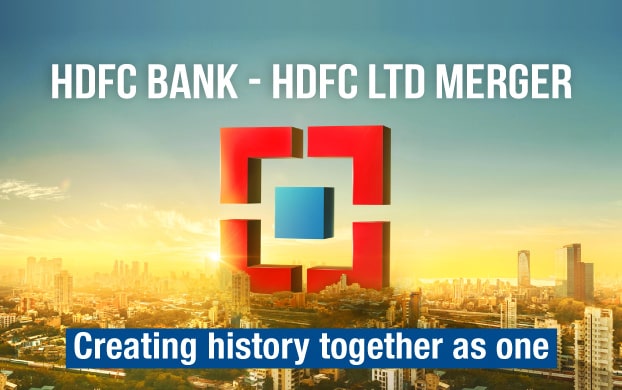by APAS Team
Share
by APAS Team
Share

HDFC Bank Completes Merger, Forging a Financial Powerhouse and Global Leader
In an incredible leap forward, HDFC Bank, one of India’s leading financial institutions, recently wrapped up its merger with its parent company on April 4, 2022. This all-stock deal, valued at a whopping $40 billion, has given birth to an unstoppable force in the financial services arena. With combined assets exceeding Rs 18 trillion, the newly formed entity is all set to revolutionize the industry and offer an extensive range of products and services to its valued customers. This merger also opens up exciting opportunities for HDFC Bank to expand its reach, both at home and abroad, diversify its loan portfolio, and reduce its reliance on corporate loans.
Why the Merger Makes Sense:
Several key factors came together to make the timing of this merger just right. Firstly, the prevailing low-interest rate environment created a supportive backdrop for this monumental financial transaction. Additionally, the Reserve Bank of India’s decision to lower the Cash Reserve Ratio (CRR) and Statutory Liquidity Ratio (SLR) requirements from 27% to 22% further greased the wheels of the merger process. Lastly, the abundance of liquidity in the system made this deal not just a possibility but a highly feasible one. Moreover, the tightening regulations imposed by the RBI on non-banking financial companies (NBFCs) have made it incredibly challenging for them to raise funds. Given this regulatory environment, HDFC Bank saw the merger as a strategic move to navigate the evolving landscape.
Benefits Galore:
The merger between HDFC Bank and its parent company holds a treasure trove of advantages for both entities. By pooling their strengths, they aim to create a financial services titan capable of providing an extensive range of top-notch products and services. The expanded customer base resulting from this merger will allow HDFC Bank to further deepen its roots in the Indian market and spread its wings globally. Additionally, the merger will enable the bank to diversify its loan portfolio, reducing its dependence on corporate loans and focusing more on meeting the needs of individual customers. This shift in focus perfectly aligns with the changing market dynamics and the evolving preferences of consumers.
Enhancing Balance Sheet Strength and Resilience:
The merger will enhance the balance sheet strength and resilience of the merged entity, as well as its ability to lend to various segments of the economy, including infrastructure, affordable housing, MSMEs, and retail. The larger net-worth will also allow the merged entity to underwrite bigger ticket loans and participate in consortium lending.
Beneficial for Shareholders:
The merger will be beneficial for the shareholders of both the entities, as they will receive shares in the merged entity based on a fair exchange ratio. The merger will also enhance the earnings per share and return on equity of the merged entity, as well as its dividend payout ratio.
Reducing Regulatory Burden and Compliance Costs:
The merger would also reduce the regulatory burden and compliance costs for both entities, as they would be subject to a single regulator and set of norms.
Synergies in Liabilities and Enhanced Deposit Base:
The merger holds several key advantages, particularly in the realm of liabilities. This consolidation presents an opportunity for HDFC Bank to capitalize on HDFC Ltd.’s low-cost and stable sources of funds, including bonds, debentures, and external commercial borrowings. By leveraging these resources, the bank can optimize its funding structure and potentially reduce borrowing costs. Conversely, HDFC Ltd. stands to benefit from the merger by gaining access to HDFC Bank’s expansive network of branches, ATMs, and digital platforms. This strategic advantage allows HDFC Ltd. to expand its deposit base, lessening its reliance on wholesale funding and broadening its customer reach.
The amalgamation also facilitates cross-selling opportunities, enabling both entities to offer a wider range of products and services, such as savings accounts, credit cards, insurance, and mutual funds, to their existing and new customers.
Moreover, the merger is set to enhance the deposit base of the combined bank. With HDFC Ltd.’s substantial and loyal customer base of housing loan borrowers, there is a strong likelihood that these borrowers will shift their savings accounts to HDFC Bank. This migration of funds will result in a lower cost of funds for the bank, as deposits generally offer cheaper funding compared to other sources like wholesale borrowings or market instruments.
In addition to bolstering the deposit base, the merger diversifies the asset portfolio of the bank. The inclusion of the housing loan segment, which is relatively low-risk and high-return, will be particularly advantageous. Housing loans are typically secured by mortgages, reducing the credit risk for the lender. Furthermore, these loans tend to have long-term maturities, aligning well with the bank’s long-term liabilities, such as deposits. Consequently, this will lead to an improved asset-liability matching, ultimately reducing the interest rate risk faced by the bank.
Shaking Up the Market:
The merged entity’s shares will carry substantial weightage on the stock indices, accounting for close to 14% of the overall index. This places it ahead of the current heavyweight, Reliance Industries, which holds a weightage of 10.4%. The increased prominence of HDFC Bank in the stock market will make its share price movements significantly influential, potentially shaping the broader Indian stock market. Furthermore, the merger will catapult HDFC Bank to the position of the second-largest firm in India by market capitalization, cementing its status as a major player in the financial industry.
Sharing the Ownership and Building Subsidiaries:
The merger ratio between HDFC Bank and HDFC Ltd tilted in favour of HDFC Ltd shareholders, with existing shareholders owning a solid 41% of the merged entity. To ensure a fair distribution of ownership, each HDFC shareholder received 42 shares of HDFC Bank for every 25 shares held. This approach solidified the merger’s legitimacy and created a strong sense of unity. Additionally, the merger expanded HDFC Bank’s family of subsidiaries, which now include HDFC Securities, HDFC AMC, HDFC Ergo GIC, HDFC Capital Advisors, and HDFC Life Insurance. The performance of these subsidiaries may influence the share price of HDFC Bank post-merger, making them essential factors to monitor for investors.
Going Global, Gaining Respect:
The merger has propelled the newly formed entity to become the world’s seventh-largest bank by market capitalization. It’s quite a remarkable journey from its humble beginnings as a mortgage firm in the 1980s, with a market capitalization of less than Rs. 500 crores. Now, the merger has resulted in a combined market capitalization of Rs. 12.66 lakh crores for HDFC Bank. After the merger, HDFC Bank’s market cap has surpassed that of major global investment firms like Morgan Stanley ($143 billion) and Goldman Sachs ($108 billion). With a valuation of approximately $152 billion, the merged entity ranks as the seventh-largest lender globally and the third most valuable company in India by market capitalization after Reliance Industries (Rs 18.6 lakh crore) and TCS (Rs 12.9 lakh crore).
In a nutshell, the successful completion of the merger between HDFC Bank and its parent company marks a major milestone in the financial sector. It has given birth to a financial powerhouse that stands tall as a global leader. The merger’s rationale, coupled with the benefits of expanded product offerings and a wider customer base, solidifies HDFC Bank’s position as a trailblazer in the industry. With its significant impact on the market, balanced ownership distribution, and the inclusion of strong subsidiaries, HDFC Bank’s future shines brightly, establishing it as a major player both in the Indian and global financial markets.
Finally, the merger is not just a consolidation; it aspires instead to become a dynamic “technology company” that is into banking.

Chinmay Narkhede
STAY IN THE LOOP
Subscribe to our free newsletter.
The slower economic growth caused by regulatory accumulation could well [...]
Navigating the Future of Consulting: The Role of Digital Transformation [...]
Previous Irdai leaderships wanted a stable industry. So, very little [...]



